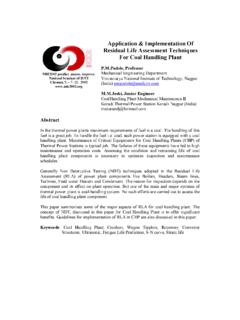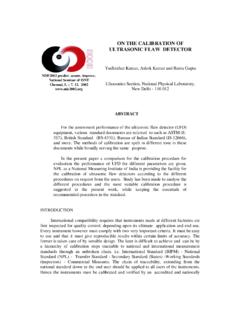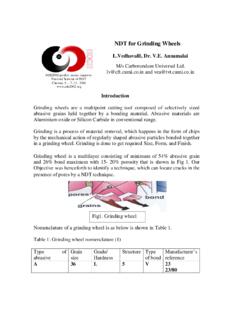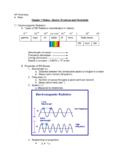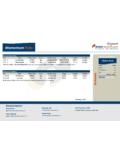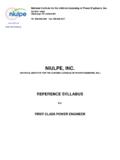Transcription of Assessment of Quality and Acceptance Criteria of ...
1 NDE2002 predict. assure. Se minar of ISNT Chennai, 5. 7. 12. 2002 Assessment of Quality and Acceptance Criteria of continuous cast Steel blooms by Comparing ultrasonic signals and Macro structure Aristatil, S. Prasanna Venkatesan Assessment of Quality and Acceptance Criteria of continuous cast Steel blooms by Comparing ultrasonic signals and Macro structure ( G. Aristatil 1, S. Prasanna Venkatesan 2 ) Introduction:- The Quality of product will mainly depend upon the Quality of raw material. The Assessment of Quality at the raw material stage will go a long way in assessing the final product Quality and also saving on unproductive working of several forming machines. It has been the normal practice to manufacture tubes & pipes from the rolled billets. The introduction of continuous cast blooms for the manufacture of tubes & pipes is gaining momentum due to the fact that the elimination of hot rolling has a direct bearing on the productivity and the cost of manufacture.
2 Since the concast+ material has as cast structure , the ultrasonic indications have to be freshly studied with respect to macro structure of the bloom. This will enable for the proper Assessment of the Quality of the raw material Vis- -Vis the Acceptance Criteria of the new ly introd uced raw material. The advantage expected out of this project is to fix the scientific means of Non-destructively setting the Acceptance standard for these billets. The benefit being avoidance of processing defective billets which is eventually being rejected as that tube or pipe leading to slippage on customer Commitments. Concast Billets: In the early 1940 ' s research and development resulted in the perfection of methods for the continuous casting of molten steel directly into the form of Billets, by-passing the ingot stage and the necessity for hot rolling operations formerly required to produce such products.
3 Defects: - The Quality of continuously cast steel is dependent on the steel making and casting practices employed. It is affected by the interaction of chemical and physical factors, which must be closely controlled to obtain the full potential of the process. Typical defects experienced in con-cast Billets are Surface Longitudinal and transverse Cracks. Laps, Scale and entrapped inclusions and slag oscillation marks. + Concast is a general term used for Continuous casting 1. (NDT),Department of Physics, Regional Engineering College-Trichy-620015 2. , Senior manager/ Quality control,Seamless Steel Tube Plant (SSTP),BHEL-Trichy-620014 Sub Surface Pinholes, blow holes inclusions Cracks Internal Cracks Porosity inclusions Segre gatio n Experimentation: Testing is done with ESM2 /EEC make on blooms with normal probe of MHz with 10 mm dia for segregating defective blooms.
4 Water is used as couplant. Scanning is done 100 %for a distance of 200 mm at the beginning and end of the bloom and sinusoidal scanning for the remaining portion on two mutually perpendicular sides of the bloom . Reference standard is a block made from the bloom with three holes of 4mm each drilled at T , T and T to draw DAC. The Acceptance Criteria is based on international steel manufacturers recommendation and it stipulates that any defect signal exceeding 20% of the back wall echo or defect signal exceeding 100% of the DAC shall be considered for rejection. No reduction of backwall echo is permitted. Test was conducted on number of blooms based on this procedure . The defect signals amplitude and their locations are recorded along with the length of the defect (later identified as micro cracks in the macro examination) This test is repeated on many more blooms to establish the repeatability.
5 (as show n i n fig3) Sample Preparation:- The defective portions on blooms are marked and made into sections by oxy - acetylene flame cutting following grinding for macro examination. The section of bloom , called billet is as shown in fig1. Macro etching: - The macro etching of the section of the bloom( 25 mm) was carried out with solution of hot hydrochloric acid solution.. With high resolution Camera, Photographs has been taken for these samples. The Macro structure of section of billets are as shown in fig2. Results: Section of Billet DE BWE De pth Crack Length 1 100% 30% 30mm 10mm 3 100% 30% 32mm 10mm 3 80% 50% 32mm 5mm 5 80% 50% 32mm 5mm 2 50% 40% 32mm 3mm 4 50% 40% 32mm 3mm Results and Discussion: Sections 1 &3:- The Macrograph of billet section 1 and section 2 shows the inter dendritic cracks as shown in fig2.
6 Also it shows the best-known form of internal defect the so-called segregation cracking resulting from tensile and compressive stresses near the still thin strand shell in Bloom caster. The defect echo of 100% with Back wall echo of 30% at a depth of approximately 32mm is the UT response.. The crack length obtained is nearly 10mm. The segregation of micro pores is also seen around the center of billet. The common rule followed for rejection of bloom is amplitude of DE and the reduction of BWE. In the sections 1 & 3, it is observed that 10mm cracks at same depth gives the same echo pattern of DE:100%, BWE:30%. Hence crack length is consistent with echo pattern. Sections 3 & 5:- Here the crack length of 5mm is observed at a depth of 32mm ,with UT echo pattern of DE: 80% and BWE: 50%.
7 So for the crack length of 5mm the echo pattern is 80/50. Sections 2 & 4:- Here the crack length of 3mm is observed at a depth of 32mm with UT echo pattern of DE:50% BWE:40%. For the crack of 3mm length the echo pattern is 50/40. Conclusion:- The test is carried out in number of Billets and number of sections of Billets. UT signal pattern is consistent with Crack lengths .Hence these data s namely defect echo and or the reduction of backwall echo exceeding 50%can be used as an Acceptance Criteria for selecting Good CC blooms for the manufacture of high Quality tubes and pipes. References 1. South West Research Institute 1998, Annual report NDT 2. ARTICLES 1984 - 1989 ASNT - Journal 3. ASTM Journal of testing and evaluation Vol -25, , 1997 4. Steel Times Journal Vol 220, , 1992 5.
8 Materials evaluation Journal Vol 50, , Aug 1992 6. The British Journal of NDT Vol 30, July 1998 7. Metals Hand Book-Vol-17,8 8. ASNT Hand Book, Vol-7,10 9. Continuous Casting of Steel IRSID, BIARRITZ 1976 10. ASTM-Hand Book (Metallography) 11. Continuous Casting IV international iron and steel Congress 1982 12. Ultrasonic Testing of materials Karutkramer 1990 Billets and Billet Sections Bloom1 Section5 Section4 Section3 Bloom3 Bloom4 Bloom5 Bloom2 Section2 Section1 Fig 3
